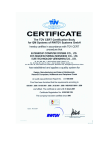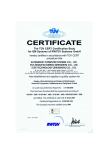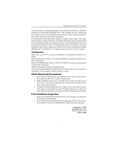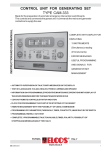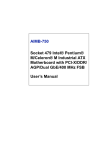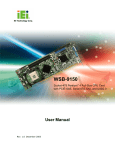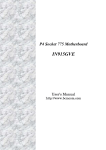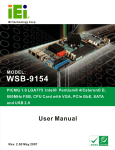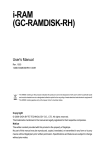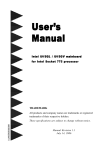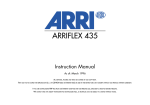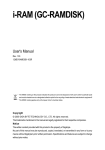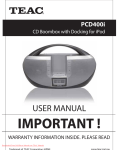Download Untitled
Transcript
Preface Copyright This publication, including all photographs, illustrations and software, is protected under international copyright laws, with all rights reserved. Neither this manual, nor any of the material contained herein, may be reproduced without written consent of the author. Version 1.0 Disclaimer The information in this document is subject to change without notice. The manufacturer makes no representations or warranties with respect to the contents hereof and specifically disclaims any implied warranties of merchantability or fitness for any particular purpose. The manufacturer reserves the right to revise this publication and to make changes from time to time in the content hereof without obligation of the manufacturer to notify any person of such revision or changes. Trademark Recognition Microsoft, MS-DOS and Windows are registered trademarks of Microsoft Corp. MMX, Pentium, Pentium-II, Pentium-III, Celeron are registered trademarks of Intel Corporation. Other product names used in this manual are the properties of their respective owners and are acknowledged. Federal Communications Commission (FCC) This equipment has been tested and found to comply with the limits for a Class B digital device, pursuant to Part 15 of the FCC Rules. These limits are designed to provide reasonable protection against harmful interference in a residential installation. This equipment generates, uses, and can radiate radio frequency energy and, if not installed and used in accordance with the instructions, may cause harmful interference to radio communications. However, there is no guarantee that interference will not occur in a particular installation. If this equipment does cause harmful interference to radio or television reception, which can be determined by turning the equipment off and on, the user is encouraged to try to correct the interference by one or more of the following measures: • • • • Reorient or relocate the receiving antenna Increase the separation between the equipment and the receiver Connect the equipment onto an outlet on a circuit different from that to which the receiver is connected Consult the dealer or an experienced radio/TV technician for help Shielded interconnect cables and a shielded AC power cable must be employed with this equipment to ensure compliance with the pertinent RF emission limits governing this device. Changes or modifications not expressly approved by the system’s manufacturer could void the user’s authority to operate the equipment. Preface ii Declaration of Conformity This device complies with part 15 of the FCC rules. Operation is subject to the following conditions: • • This device may not cause harmful interference, and This device must accept any interference received, including interference that may cause undesired operation Canadian Department of Communications This class B digital apparatus meets all requirements of the Canadian Interference-causing Equipment Regulations. Cet appareil numérique de la classe B respecte toutes les exigences du Réglement sur le matériel brouilieur du Canada. About the Manual The manual consists of the following: Chapter 1 Describes features of the motherboard. Introducing the Motherboard Go to H page 1 Describes installation of motherboard components. Chapter 2 Installing the Motherboard Go to H page 7 Provides information on using the BIOS Setup Utility. Chapter 3 Using BIOS Go to H page 27 Chapter 4 Describes the motherboard software Using the Motherboard Software Go to Preface H page 43 iii TABLE OF CONTENTS Preface i Chapter 1 1 Introducing the Motherboard 1 Introduction.................................................................................................1 Feature..........................................................................................................2 Motherboard Components........................................................................4 Chapter 2 7 Installing the Motherboard 7 Safety Precautions......................................................................................7 Choosing a Computer Case.......................................................................7 Installing the Motherboard in a Case......................................................7 Checking Jumper Settings.........................................................................8 Setting Jumpers..............................................................................8 Checking Jumper Settings..............................................................9 Jumper Settings..............................................................................9 Connecting Case Components...............................................................10 Front Panel Header.....................................................................12 Installing Hardware...................................................................................13 Installing the Processor...............................................................13 Installing Memory Modules.........................................................15 Installing a Hard Disk Drive/CD-ROM/SATA Hard Drive........17 Installing a Floppy Diskette Drive...............................................19 Installing Add-on Cards..............................................................20 Connecting Optional Devices......................................................22 Connecting I/O Devices..........................................................................26 Chapter 3 27 Using BIOS 27 About the Setup Utility............................................................................27 The Standard Configuration........................................................27 Entering the Setup Utility..............................................................28 Updating the BIOS.......................................................................29 Using BIOS................................................................................................29 Standard CMOS Setup.................................................................30 Boot Configuration Features.......................................................31 Advanced Setup............................................................................32 iv Advanced Chipset Features.........................................................37 Power Management Setup...........................................................38 Hardware Health Configuration.................................................40 BIOS Security Features................................................................41 Load Optimal Defaults................................................................42 Load FailSafe Defaults ...............................................................42 Save Changes and Exit................................................................42 Discard Changes and Exit...........................................................42 43 Chapter 4 Using the Motherboard Software 43 About the Software CD-ROM................................................................43 Auto-installing under Windows 98/ME/2000/XP................................43 Running Setup..............................................................................44 Manual Installation..................................................................................46 Utility Software Reference.......................................................................46 Multi-Language Translation 1 Chapter 1 Introducing the Motherboard Introduction Thank you for choosing the 915-M5 motherboard. This motherboard is a high performance, enhanced function motherboard that supports LGA775 Socket for latest Intel Pentium 4/Celeron processors for high-end business or personal desktop markets. The motherboard may support 915GV Northbridge (NB) and ICH6 Southbridge (SB) chipsets. The 915GV Northbridge on this motherboard supports a Front Side Bus (FSB) frequency of 800/533 MHz using a scalable FSB Vcc_CPU. The memory controller supports DDR memory DIMM frequencies of 333MHz and 400 MHz. It supports four DDR Sockets with up to maximum memory of 4 GB. DDR Maximum memory bandwidth of 3.2 GB/s in singlechannel mode and 6.4 GB/s in dual-channel mode is supported. One optional PCI Express Lite slot is used to install an external PCI Express graphics card. The ICH6 Southbridge on this motherboard supports three PCI slots which are PCI 2.3 compliant. It implements an EHCI compliant interface that provides 480Mb/s bandwidth for eight USB 2.0 ports, integrates Azalia CODEC that features a 8-channel High Definition audio output. One onboard IDE connector supports 2 IDE devices in ATA-100/66 mode. The Southbridge integrates a Serial ATA host controller that is SATA v1.0 compliant, supporting four SATA ports with maximum transfer rate up to 150 MB/s each. The 915-M5 motherboard is equipped with advanced full set of I/O ports in the rear panel, including PS/2 mouse and keyboard connectors, COM1, LPT, four USB ports, one VGA port, one optional LAN port, one optional 1394 port, and audio jacks for microphone, line-in, and 8-ch line-out. Introducing the Motherboard 2 Feature Processor The 915-M5 uses a LGA775 type of Pentium 4 that carries the following features: • Accommodates Intel P4/Celeron processors • Supports a system bus (FSB) of 800/533MHz • Supports “Hyper-Threading” technology CPU “Hyper-Threading” technology enables the operating system into thinking it’s hooked up to two processors, allowing two threads to be run in parallel, both on separate “logical” processors within the same physical processor. Chipset The 915GV Northbridge (NB) and ICH6 Southbridge (SB) chipset are based on an innovative and scalable architecture with proven reliability and performance. • Supports 32-bit host bus addressing, allowing the CPU to 915GV (NB) access the entire 4 GB of the memory address space. • Has a 12-deep In-Order Queue to support up to twelve outstanding piplined address requests on the host bus. • Supports 256-Mb, 512-Mb and 1-Gb DDR/DDR2 technologies for x8 and x16 devices • Provides an integrated graphics device delivering cost competitive 3D, 2D and video capabilities. 915GV chipset can only support 256-Mb, 512-Mb and 1-Gb DDR technologies for x8 and x16 device, NOT support 128-Mb DDR technology. That is, 256 MB Double Side Memory Module & 128 MB Single Side Memory Module are NOT support. ICH6 (SB) • • • • Memory • • • • Enhanced DMA Controller, interrupt controller, and timer functions Compliant with PCI 2.3 specificaiton Compliant with Serial ATA 1.0a specification Integrated USB 2.0 Host Controller supporting up to eight USB 2.0 ports Integrated LAN controller Integrated IDE controller supports Ultra ATA100/66/33 Accommodates four unbuffered DIMMs Up to 1 GB per DIMM with maximum memory size up to 4 GB Graphics • • • • Supports core frequency of 333 MHz Supports 3D Setup, Render Engine, and 3D Graphics Enhancements Supports High Quality Texture Engine Video DVD/PC-VCR Onboard LAN (Optional) This motherboard may support either of the following LAN chipset: • • • • • • Supports 10/Mbs and 100Mb/s N-Way Auto negotiation operation Half/Full duplex capability Supports Wake-On-LAN(WOL) function and remote wake-up Integrate 10/100/1000 transceiver Supports PCI v2.3, 32-bit, 33/66MHz Supports fully with IEEE802.3, IEEE802.3u and IEEE802.3ab Introducing the Motherboard 3 Audio This motherboard may support either of the following Audio chipset. • Compliant with the AC’97 v2.3 CODEC • Supports 6-channel audio CODEC designed for PC multimedia systems • Provides three analog line-level stereo inputs with 5-bit volume control: Line-in, CD, AUX • Supports S/PDIF output function • Compliant with Azalia specification, supporting 8 channel DACs with SNR.100dB • Capabilities: 192/96/48/44.1 KHz with 24/20/16 bits • 8 Smart Jack I/O port support • Extensive jack detection via RNM (resistors network method) that can be used to monitor the plugging status of each jack • Digital S/PDIF OUT & IN support Expansion Options The motherboard comes with the following expansion options: • • • • One PIC Express Lite slot (optional) Three 32-bit PCI v2.3 compliant slots One 40-pin IDE low profile header that support two IDE devices One floppy disk drive interface and four 7-pin SATA connectors The 915-M5 motherboard supports UltraDMA bus mastering with transfer rates of 100/66 MB/s. 1394 FireWire (Optional) • • • Compliatn with the latest IEEE 1394 standards with full 1394a P2000 support Detect connected device types and automatically configure data speeds to 100, 200 or 400 Mbps Equipped with 32-bit PCI bus interface that features advanced power management, and cardbus support Integrated I/O The motherboard has a full set of I/O ports and connectors: • Two PS/2 ports for mouse and keyboard • One serial port and one parallel port • Four USB ports • One VGA port, one 1394 port (optional) and one LAN port (optional) • Audio jacks for microphone in, line-in and line-out (Audio jack for microphone in, line-in and 8-ch High Definition Audio out if supports Azalia Audio CODEC.) Please be noted the I/O may be varied based on what chipset the motherboard supported. BIOS Firmware This motherboard uses AWARD BIOS that enables users to configure many system features including the following: • Power management • Wake-up alarms • CPU parameters • CPU and memory timing The firmware can also be used to set parameters for different processor clock speeds. Some hardware specifications and software items are subject to change with out prior notice. Introducing the Motherboard 4 Motherboard Components Introducing the Motherboard 5 Table of Motherboard Components LABEL 1 CPU Socket 2 SYS_FAN 3 CPU_FAN 4 DIMM1~4 5 FDD 6 ATX1 7 IDE1 8 CLR_CMOS 9 SPK1 10 PWR_FAN 11 IRDA 12 SATA1~4 COMPONENT LGA775 socket for Pentium 4 CPUs System fan connector CPU cooling fan connector Four 184-pin DDR SDRAM slots Floppy diskette drive connector Standard 24-pin ATX power connector Primary IDE channel Clear CMOS jumper Speaker header Power fan connector Infrared header Four serial ATA connectors 13 F_PANEL 14 COM2 15 F_USB1~F_USB2 16 BIOS_WP 17 PCI1~3 18 AUXIN1* 19 CDIN2* 20 CDIN1 21 F_AUDIO 22 SPDIF-O1 23 SPDIF-I1 Front Panel switch/LED header Onboard serial port header Front Panel USB headers BIOS flash protect jumper Three 32-bit add-on card slots Auxiliary Audio input connector Secondary CD-in connector Primary CD-in connector Front panel audio header SPDIF out header SPDIF in header 24 PCIE* PCI Express Lite slot 25 ATX12V ATX12V power connector *Stands for optional components This concludes Chapter 1. The next chapter explains how to install the motherboard. Introducing the Motherboard 6 Memo Introducing the Motherboard 7 Chapter 2 Installing the Motherboard Safety Precautions • • • • • Follow these safety precautions when installing the motherboard Wear a grounding strap attached to a grounded device to avoid damage from static electricity Discharge static electricity by touching the metal case of a safely grounded object before working on the motherboard Leave components in the static-proof bags they came in Hold all circuit boards by the edges. Do not bend circuit boards Choosing a Computer Case There are many types of computer cases on the market. The motherboard complies with the specifications for the Micro ATX system case. First, some features on the motherboard are implemented by cabling connectors on the motherboard to indicators and switches on the system case. Make sure that your case supports all the features required. Secondly, 915M5 supports one or two floppy diskette drives and two enhanced IDE drives. Make sure that your case has sufficient power and space for all drives that you intend to install. Most cases have a choice of I/O templates in the rear panel. Make sure that the I/O template in the case matches the I/O ports installed on the rear edge of the motherboard. This motherboard carries a Micro ATX form factor of 244 x 244 mm. Choose a case that accommodates this form factor. Installing the Motherboard in a Case Refer to the following illustration and instructions for installing the motherboard in a case. Most system cases have mounting brackets installed in the case, which correspond the holes in the motherboard. Place the motherboard over the mounting brackets and secure the motherboard onto the mounting brackets with screws. Ensure that your case has an I/O template that supports the I/O ports and expansion slots on your motherboard. Installing the Motherboard 8 Do not over-tighten the screws as this can stress the motherboard. Checking Jumper Settings This section explains how to set jumpers for correct configuration of the motherboard. Setting Jumpers Use the motherboard jumpers to set system configuration options. Jumpers with more than one pin are numbered. When setting the jumpers, ensure that the jumper caps are placed on the correct pins. The illustrations show a 2-pin jumper. When the jumper cap is placed on both pins, the jumper is SHORT. If you remove the jumper cap, or place the jumper cap on just one pin, the jumper is OPEN. SHORT This illustration shows a 3-pin jumper. Pins 1 and 2 are SHORT Installing the Motherboard OPEN 9 Checking Jumper Settings The following illustration shows the location of the motherboard jumpers. Pin 1 is labeled. Jumper Settings Jumper Type Description Setting (default) CLR_CMOS 3-pin Clear CMOS 1-2: CLEAR CMOS 2-3: NORMAL Before clearing the CMOS, make sure to turn off the system. BIOS_WP 2-pin BIOS_WP 1 CLR_CMOS OPEN: FLASH WRITE UNPROTECTED SHORT: FLASH WRITE PROTECTED Installing the Motherboard BIOS_WP 10 Connecting Case Components After you have installed the motherboard into a case, you can begin connecting the motherboard components. Refer to the following: 1 2 3 3 4 6 7 Connect the CPU cooling fan cable to CPU_FAN. Connect the case cooling fan connector to SYS_FAN. Connect the auxiliary power supply cooling fan connector to PWR_FAN. Connect the case speaker cable to SPK1. Connect the case switches and indicator LEDs to the F_PANEL. Connect the standard power supply connector to ATX1. Connect the auxiliary case power supply connector to ATX12V. Connecting 20/24-pin power cable Users please note that the 20-pin and 24-pin power cables can both be connected to the ATX1 connector. With the 20-pin power cable, just align the 20-pin power cable with the pin 1 of the ATX1 connector. However, using 20-pin power cable may cause the system to become unbootable or unstable because of insufficient electricity. A minimum power of 300W is recommended for a fully-configured system 20-pin power cable Users please note that when installing 20pin power cable, the latche of power cable falls on the left side of the ATX1 connector latch, just as the picture shows. Users please note that when installing 24pin power cable, the latches of power cable and the ATX1 match perfectly. 24-pin power cable Installing the Motherboard 11 CPU_FAN: FAN Power Connector Pin 1 2 3 4 Signal Name GND Function System Ground Power +12V Sensor FAN Speed control +12V Sense Control Users please note that the fan connector supports the CPU cooling fan of 1.1A~2.2A (26.4W max) at +12V. PWR_FAN/SYS_FAN: FAN Power Connectors Pin 1 2 3 Signal Name Function System Ground Power +12V Sensor GND +12V Sense SPK1: Internal speaker Pin 1 2 3 4 Signal Name VCC Key NO Signal ATX1: ATX 24-pin Power Connector Pin Signal Name 1 2 3 4 5 6 7 8 9 +3.3V 10 11 12 +12V +3.3V Ground +5V Ground +5V Ground PWRGD +5VSB +12V +3.3V Pin 13 14 15 16 17 18 19 20 21 22 23 24 Signal Name +3.3V -12V COM PS_ON COM COM COM -5V +5V +5V +5V COM Installing the Motherboard 12 ATX12V: ATX 12V Power Connector Pin 1 2 3 4 Signal Name +12V +12V Ground Ground Front Panel Header The front panel header (F_PANEL) provides a standard set of switch and LED headers commonly found on ATX or Micro-ATX cases. Refer to the table below for information: Pin Signal Function Pin Signal Function 1 HD_LED_P Hard disk LED+ 2 FP PWR/SLP *MSG LED+ 3 HD_LED_N Hard disk LED- 4 FP PWR/SLP *MSG LED- 5 RST_SW_N Reset Switch 6 PWR_SW_P Power Switch 7 RST_SW_P Reset Switch 8 PWR_SW_N Power Switch 9 RSVD Reserved 10 Key No pin * MSG LED (dual color or single color) Hard Drive Activity LED Connecting pins 1 and 3 to a front panel mounted LED provides visual indication that data is being read from or written to the hard drive. For the LED to function properly, an IDE drive should be connected to the onboard IDE interface. The LED will also show activity for devices connected to the SCSI (hard drive activity LED) connector. Power/Sleep/Message waiting LED Connecting pins 2 and 4 to a single or dual-color, front panel mounted LED provides power on/off, sleep, and message waiting indication. Reset Switch Supporting the reset function requires connecting pin 5 and 7 to a momentary-contact switch that is normally open. When the switch is closed, the board resets and runs POST. Power Switch Supporting the power on/off function requires connecting pins 6 and 8 to a momentarycontact switch that is normally open. The switch should maintain contact for at least 50 ms to signal the power supply to switch on or off. The time requirement is due to internal debounce circuitry. After receiving a power on/off signal, at least two seconds elapses before the power supply recognizes another on/off signal. Installing the Motherboard 13 Installing Hardware Installing the Processor Caution: When installing a CPU heatsink and cooling fan make sure that you DO NOT scratch the motherboard or any of the surface-mount resistors with the clip of the cooling fan. If the clip of the cooling fan scrapes across the motherboard, you may cause serious damage to the motherboard or its components. On most motherboards, there are small surface-mount resistors near the processor socket, which may be damaged if the cooling fan is carelessly installed. Avoid using cooling fans with sharp edges on the fan casing and the clips. Also, install the cooling fan in a well-lit work area so that you can clearly see the motherboard and processor socket. Before installing the Processor This motherboard automatically determines the CPU clock frequency and system bus frequency for the processor. You may be able to change these settings by making changes to jumpers on the motherboard, or changing the settings in the system Setup Utility. We strongly recommend that you do not over-clock processors or other components to run faster than their rated speed. Warning: Over-clocking components can adversely affect the reliability of the system and introduce errors into your system. Over-clocking can permanently damage the motherboard by generating excess heat in components that are run beyond the rated limits. This motherboard has a LGA775 socket. When choosing a processor, consider the performance requirements of the system. Performance is based on the processor design, the clock speed and system bus frequency of the processor, and the quantity of internal cache memory and external cache memory. Installing the Motherboard 14 CPU Installation Procedure The following illustration shows CPU installation components. A. Unload the cap · Use thumb & forefinger to hold the lifting tab of the cap. · Lift the cap up and remove the cap completely from the socket. B. Open the load plate · Use thumb & forefinger to hold the hook of the lever, pushing down and pulling aside unlock it. · Lift up the lever. · Use thumb to open the load plate. Be careful not to touch the contacts. C. Install the CPU on the socket · Orientate CPU package to the socket. Make sure you match triangle marker to pin 1 location. D. Close the load plate · Slightly push down the load plate onto the tongue side, and hook the lever. · CPU is locked completely. E. Apply thermal grease on top of the CPU. F. Fasten the cooling fan supporting base onto the CPU socket on the motherboard. G. Make sure the CPU fan is plugged to the CPU fan connector. Please refer to the CPU cooling fan user’s manual for more detail installation procedure. To achieve better airflow rates and heat dissipation, we suggest that you use a high quality fan with 3800 rpm at least. CPU fan and heatsink installation procedures may vary with the type of CPU fan/heatsink supplied. The form and size of fan/heatsink may also vary. Installing the Motherboard 15 Installing Memory Modules This motherboard accommodates four 184-pin 2.5V unbuffered DIMM and supports DDR333/400. You must install at least one module in any of the four slots. Each module can be installed with 256MB to 1GB of memory; the total memory capacity is 4GB. DDR SDRAM memory module table Memory module DDR 333 DDR 400 Memory Bus 166MHz 200MHz Do not remove any memory module from its antistatic packaging until you are ready to install it on the motherboard. Handle the modules only by their edges. Do not touch the components or metal parts. Always wear a grounding strap when you handle the modules. Installation Procedure Refer to the following to install the memory modules. 1 2 3 4 5 6 This motherboard supports unbuffered DDR and DDR2 SDRAM . Push the latches on each side of the DIMM slot down. Align the memory module with the slot. The DIMM slots are keyed with notches and the DIMMs are keyed with cutouts so that they can only be installed correctly. Check that the cutouts on the DIMM module edge connector match the notches in the DIMM slot. Install the DIMM module into the slot and press it firmly down until it seats correctly. The slot latches are levered upwards and latch on to the edges of the DIMM. Install any remaining DIMM modules. Installing the Motherboard 16 Table A: DDR (memory module) QVL (Qualified Vendor List) The following DDR400 memory modules have been tested and qualified for use with this motherboard. Size 256MB 512 MB Vendor GEIL Samsung Kingston HYNIX Apacer Samsung CORSAIR Kingston GEIL GEIL Samsung Kingston HYNIX Apacer GEIL Ramaxel Samsung CORSAIR Kingston GEIL Kingston Samsung GEIL Kingston Samsung GEIL Model Name GE08L3264D1WL5NKT3H71 K4H560838D-TCCC D3208DL2T-5 0323PT01 HY5DU5656822BT-D43 AM3A568ACT-5A K4H560838E-TCCC CMX256 3200C2PT K4H560838D-TCC4 G216L6464D2TG5NKT2L GE08L3264D1WL5NKT3H71 K4H560838D-TCCC D3208DL2T-5 0323PT01 HY5DU5656822BT-D43 AM3A568ACT-5A G208L364D1TG5NKT3C MT-46V32M8 TG-5BC K4H560838E-TCCC CMX256 3200C2PT K4H560838D-TCC4 G216L6464D2TG5NKT2L SAMSUNG K4H560838D-TCC4 K4H560838E-TCCC GE16L6464D2 WL5NKT3H66 SAMSUNG K4H560838D-TCC4 K4H560838E-TCCC GE16L6464D2 WL5NKT3H66 Installing the Motherboard 17 Installing a Hard Dish Drive/CD-ROM/SATA Hard Drive This section describes how to install IDE devices such as a hard disk drive and a CD-ROM drive. About IDE Devices Your motherboard has one IDE channel interface. An IDE ribbon cable supporting two IDE devices is bundled with the motherboard. You must orient the cable connector so that the pin1 (color) edge of the cable correspoinds to the pin 1 of the I/O port connector. IDE1: IDE Connector This motherboard supports four high data transfer SATA ports with each runs up to 150 MB/s. To get better system performance, we recommend users connect the CD-ROM to the IDE channel, and set up the hard dives on the SATA ports. IDE devices enclose jumpers or switches used to set the IDE device as MASTER or SLAVE. Refer to the IDE device user’s manual. Installing two IDE devices on one cable, ensure that one device is set to MASTER and the other device is set to SLAVE. The documentation of your IDE device explains how to do this. Installing the Motherboard 18 About SATA Connectors Your motherboard features four SATA connectors supporting a total of four drives. SATA , or Serial ATA (Advanced Technology Attachment) is the standard interface for the IDE hard drives which are currently used in most PCs. These connectors are well designed and will only fit in one orientation. Locate the SATA connectors on the motherboard and follow the illustration below to install the SATA hard drives. Installing Serial ATA Hard Drives To install the Serial ATA (SATA) hard drives, use the SATA cable that supports the Serial ATA protocol. This SATA cable comes with an SATA power cable. You can connect either end of the SATA cable to the SATA hard drive or the connector on the motherboard. SATA cable Refer to 1 2 3 (optional) SATA power cable (optional) the illustration below for proper installation: Attach either cable end to the connector on the motherboard. Attach the other cable end to the SATA hard drive. Attach the SATA power cable to the SATA hard drive and connect the other end to the power supply. This motherboard does not support the “Hot-Plug” function. Installing the Motherboard 19 Installing a Floppy Diskette Drive The motherboard has a floppy diskette drive (FDD) interface and ships with a diskette drive ribbon cable that supports one or two floppy diskette drives. You can install a 5.25-inch drive and a 3.5-inch drive with various capacities. The floppy diskette drive cable has one type of connector for a 5.25-inch drive and another type of connector for a 3.5-inch drive. You must orient the cable connector so that the pin 1 (color) edge of the cable corresponds to the pin 1 of the I/O port connector. FDD: Floppy Disk Connector This connector supports the provided floppy drive ribbon cable. After connecting the single end to the onboard floppy connector, connect the remaining plugs on the other end to the floppy drives correspondingly. Installing the Motherboard 20 Installing Add-on Cards The slots on this motherboard are designed to hold expansion cards and connect them to the system bus. Expansion slots are a means of adding or enhancing the motherboard’s features and capabilities. With these efficient facilities, you can increase the motherboard’s capabilities by adding hardware that performs tasks that are not part of the basic system. PCI Express The PCI Express Lite slot is used to install an external PCI Express graphics Lite Slot card. PCI Slot PCI slots are used to install expansion cards that have the 32-bit PCI interface. Before installing an add-on card, check the documentation for the card carefully. If the card is not Plug and Play, you may have to manually configure the card before installation. Installing the Motherboard 21 Table A: Supported PCI Express Lite Cards List VGA Chip nVIDIA ATI Model name MSI NX6600-TD128SE 128MB (16X) ELSA GLADIAC 660 128T 128MB (16x) NVIDIA PCX5300 128MB (16X) NVIDIA PCX5750 128MB (16X) WinFast PX360TD 128MB (16X) ELSA PCX5900 128MB (16X) RX300SE-128TD V:1.D 128MB (16X) MSI X600 128MB (16X) ELSA X600 128MB (16X) Installing the Motherboard 22 Follow these instructions to install an add-on card: 1 2 3 Remove a blanking plate from the system case corresponding to the slot you are going to use. Install the edge connector of the add-on card into the expansion slot. Ensure that the edge connector is correctly seated in the slot. Secure the metal bracket of the card to the system case with a screw. For some add-on cards, for example graphics adapters and network adapters, you have to install drivers and software before you can begin using the add-on card. Connecting Optional Devices Refer to the following for information on connecting the motherboard’s optional devices: Installing the Motherboard 23 F_USB1/F_USB2: Front Panel USB headers The motherboard has four USB ports installed on the rear edge I/O port array. Additionally, some computer cases have USB ports at the front of the case. If you have this kind of case, use auxiliary USB connector to connect the front-mounted ports to the motherboard. Pin Signal Name Function 1 2 3 4 5 6 7 USBPWR Front Panel USB Power USBPWR Front Panel USB Power USB_FP_P0- USB Port 0 Negative Signal USB_FP_P1- USB Port 1 Negative Signal USB_FP_P0+ USB Port 0 Positive Signal USB_FP_P1+ USB Port 1 Positive Signal GND Ground 8 9 10 GND Ground Key No pin USB_FP_OC0 Overcurrent signal Please make sure that the USB cable has the same pin assignment as indicated above. A different pin assignment may cause damage or system hand-up. AUXIN1: Auxiliary-in connector (optional) This connector is an additional line-in audio connector. It allows you to attach a line-in cable when your rear line-in jack is set as line out port for 4-channel function. Pin Signal Name 1 2 3 4 AUXIN_L AGND AGND AUXIN_R Function AUX In left channel Ground Ground AUX In right channel CDIN1: Primary CD-in connector Pin Signal Name 1 2 3 4 CD _L GND GND CD _R CDIN2: Secondary CD-in connector (optional) Pin 1 2 3 4 Signal Name CD-GND CD-R CD-GND CD-L Installing the Motherboard 24 F_AUDIO: Front Panel Audio header This header allows the user to install auxiliary front-oriented microphone and line-out ports for easier access. Pin Signal Name Function 1 2 3 4 5 6 7 AUD_MIC Front Panel Microphone input signal AUD_GND Ground used by Analog Audio Circuits 8 9 10 Key No Pin AUD_F_L Left Channel Audio signal to Front Panel AUD_RET_L Left Channel Audio signal to Return from Front Panel AUD_MIC_BIAS Microphone Power AUD_VCC Filtered +5V used by Analog Audio Circuits AUD_FPOUT_R Right Channel audio signal to Front Panel AUD_RET_R RightChannelAudiosignaltoReturnfromFrontPanel HP_ON Reserved for future use to control Headphone Amplifier AUDIO1: Front Panel Audio header for Azalia This header allows the user to install auxiliary front-oriented microphone and line-out ports for easier access. Pin Signal Name 1 2 3 4 5 6 7 PORT-FL 8 9 10 Key GND PORT-FR ACZ-DET PORT-ER AGND SENSE B PORT-EL GND If your front panel cable is seperated, please connect it to pin1 and pin3 or pin5 and pin7 to activate the MIC function. IRDA: Infrared header The motherboard supports an Infrared (IRDA) data port. Infrared ports allow the wireless exchange of information between your computer and similarly equipped devices such as printers, laptops, Personal Digital Assistants (PDAs), and other computers. Pin 1 Pin 2 3 4 5 6 Signal Name RSVD Description No Pin IR Power, +5V Ground IR_Tx IR_Rx Installing the Motherboard 25 SATA1/2/3/4: Serial ATA connectors These connectors are use to support the new Serial ATA devices for the highest date transfer rates (150 MB/s), simpler disk drive cabling and easier PC assembly. It eliminates limitations of the current Parallel ATA interface. But maintains register compatibility and software compatibility with Parallel ATA. Pin Pin 1 3 5 7 Signal Name Signal Name Ground Pin 2 4 6 - TXRXGround Signal Name Function TX+ Ground RX+ - SPDIF-I1: SPDIF in header This is an optional header that provides an S/PDIF (Sony/Philips Digital Interface) input to digital multimedia device through optical fiber or coxial connector. Pin Pin 1 2 3 Signal Name Signal Name VCC3 GND SPDIF Function Function Power Ground SPDIF digital input SPDIF-O1: SPDIF out header This is an optional header that provides an S/PDIF (Sony/Philips Digital Interface) output to digital multimedia device through optical fiber or coxial connector. Pin Pin 1 2 3 4 Signal Name Signal Name SPDIF +5VA Key GND Function Function SPDIF digital output 5V analog power No pin Ground COM2: Onboard serial port header Connect a serial port extension bracket to this header to add a second serial port to your system. Pin Signal Name 1 2 3 4 5 6 7 NDCDB 8 9 10 Function Data carry detect NSINB Serial Data In NSOUTB Serial Date Out NDTRB Data terminal ready GND Ground NDSRB Date set ready NRTSB Request to send NCTSB Clear to send NRIB Ring Indicator Key No pin Installing the Motherboard 26 Connecting I/O Devices The backplane of the motherboard has the following I/O ports: PS2 Mouse Use the upper PS/2 port to connect a PS/2 pointing device. PS2 Keyboard Use the lower PS/2 port to connect a PS/2 keyboard. Parallel Port (LPT1) Use LPT1 to connect printers or other parallel communications devices. Serial Port (COM1) Use the COM port to connect serial devices such as mice or fax/modems. COM1 is identified by the system as COM1/3. VGA Port Connect your monitor to the VGA port. LAN Port (optional) Connect an RJ-45 jack to the LAN port to connect your computer to the Network. USB Ports Use the USB ports to connect USB devices. Audio Ports Use the audio jacks to connect audio devices. The D port is for stereo line-in signal, while the F port is for microphone in signal. This motherboard supports 8-channel audio devices that correspond to the A, B, C, and E port respectively. In addition, all of the 3 ports, B, C, and E provide users with both right & left channels individually. Users please refer to the following note for specific port function definition. A: Center & Woofer B: Back Surround C: Side Surround D: Line-in E: Front Out F: Mic_in Rear The above port definition can be changed to audio input or audio output by changing the driver utility setting. This concludes Chapter 2. The next chapter covers the BIOS. Installing the Motherboard 27 Chapter 3 Using BIOS About the Setup Utility The computer uses the latest American Megatrends BIOS with support for Windows Plug and Play. The CMOS chip on the motherboard contains the ROM setup instructions for configuring the motherboard BIOS. The BIOS (Basic Input and Output System) Setup Utility displays the system’s configuration status and provides you with options to set system parameters. The parameters are stored in battery-backed-up CMOS RAM that saves this information when the power is turned off. When the system is turned back on, the system is configured with the values you stored in CMOS. The BIOS Setup Utility enables you to configure: • Hard drives, diskette drives and peripherals • Video display type and display options • Password protection from unauthorized use • Power Management features The settings made in the Setup Utility affect how the computer performs. Before using the Setup Utility, ensure that you understand the Setup Utility options. This chapter provides explanations for Setup Utility options. The Standard Configuration A standard configuration has already been set in the Setup Utility. However, we recommend that you read this chapter in case you need to make any changes in the future. This Setup Utility should be used: • when changing the system configuration • when a configuration error is detected and you are prompted to make changes to the Setup Utility • when trying to resolve IRQ conflicts • when making changes to the Power Management configuration • when changing the password or making other changes to the Security Setup Entering the Setup Utility When you power on the system, BIOS enters the Power-On Self Test (POST) routines. POST is a series of built-in diagnostics performed by the BIOS. After the POST routines are completed, the following message appears: Using BIOS 28 Press DEL to enter SETUP Press the delete key to access the BIOS Setup Utility: CMOS Setup Utility -- Copyright (C) 1985-2004, American Megatrends, Inc. BIOS Security Features Standard CMOS Setup Boot Configuration Features Load Optimal Defaults Advanced Setup Load Failsafe Defaults Advanced Chipset Features Save Changes and Exit Power Management Features Discard Changes and Exit Hardware Health Configuration : Move Enter : Select +/-/: Value F10: Save ESC: Exit F1: General Help F7:Previous Values F8:Fail-Safe Defaults F9: Optimized Defaults Standard CMOS setup for changing time, date, hard disk type, etc. v02.56 (C)Copyright 1985-2004, American Megatrends, Inc. BIOS Navigation Keys The BIOS navigation keys are listed below: KEY FUNCTION ESC Exits the current menu +/F1 Modifies the selected field’s values Displays a screen that describes all key functions F7 Loads Previous Values Scrolls through the items on a menu F8 Loads Failsafe Defaults F9 Loads an optimized setting for better performance F10 Saves the current configuration and exits setup ESC Exits the current menu Using BIOS 29 Updating the BIOS You can download and install updated BIOS for this motherboard from the manufacturer’s Web site. New BIOS provides support for new peripherals, improvements in performance, or fixes for known bugs. Install new BIOS as follows: 1 If your motherboard has a BIOS protection jumper, change the setting to allow BIOS flashing. 2 If your motherboard has an item called Firmware Write Protect in Advanced BIOS features, disable it. (Firmware Write Protect prevents BIOS from being overwritten. 3 Create a bootable system disk. (Refer to Windows online help for information on creating a bootable system disk.) 4 Download the Flash Utility and new BIOS file from the manufacturer’s Web site. Copy these files to the system diskette you created in Step 3. 5 Turn off your computer and insert the system diskette in your computer’s diskette drive. (You might need to run the Setup Utility and change the boot priority items on the Boot Configuration Features, to force your computer to boot from the floppy diskette drive first.) 6 At the A:\ prompt, type the Flash Utility program name and the file name of the new BIOS, then press <Enter> 7 When the installation is complete, remove the floppy diskette from the diskette drive and restart your computer. If your motherboard has a Flash BIOS jumper, reset the jumper to protect the newly installed BIOS from being overwritten. Using BIOS When you start the Setup Utility, the main menu appears. The main menu of the Setup Utility displays a list of the options that are available. A highlight indicates which option is currently selected. Use the cursor arrow keys to move the highlight to other options. When an option is highlighted, execute the option by pressing <Enter>. Some options lead to pop-up dialog boxes that prompt you to verify that you wish to execute that option. Other options lead to dialog boxes that prompt you for information. Some options (marked with a triangle ) lead to submenus that enable you to change the values for the option. Use the cursor arrow keys to scroll through the items in the submenu. In this manual, default values are enclosed in parenthesis. Submenu items are denoted by a triangle . Using BIOS 30 Standard CMOS Setup This option displays basic information about your system. CMOS Setup Utility - Copyright (C) 1985-2004, American Megatrends, Inc. Standard CMOS Setup System Overview Help Item AMIBIOS Version Build Date ID : 08.00.11 : 10/22/04 : 915-M5 Processor Type Speed Count : Genuine Intel (R) CPU 3.20GHz : 3200MHz :1 Use [ENTER], [TAB] or [SHIFT-TAB] TO select a field. Use [+] or [-] to configure system Time. System Memory Size : 512MB System Time Saystem Date [00:04:43] [Tue 06/08/2004] F1: General help : Move Enter : Select +/-/: Value F10: Save ESC: Exit F7:Previous Values F8:Fail-Safe Defaults F9: Optimized Defaults Processor The item is automatically detected by the system at start up time. The Processor item shows the processor type and speed installed in your computer. This is display-only field. You cannot make changes to this field. System Memory The item is automatically detected by the system at start up time. The is display-only field. You cannot make changes to this field. Time and Date The Date and Time items show the current date and time on the computer. If you are running a Windows OS, these items are automatically updated whenever you make changes to the Windows Date and Time Properties utility. Press <Esc> to return to the main menu setting page. Using BIOS 31 Boot Configuration Features This option displays basic information about your system. CMOS Setup Utility - Copyright (C) 1985-2004, American Megatrends, Inc. Boot Configuration Features Boot Settings Configuration Help Item 1st Boot Device 2nd Boot Device 3rd Boot Device [1st FLOPPY DRIVE] [IC35L04AVVN07-0] [ASUS CD-S520/A] Quick Boot Quiet Boot Bootup Num-Lock [Enabled] [Enabled] [On] Specifies the boot sequence from the available devices. A device enclosed in parenthesis has been disabled in the corresponding type menu. : Move Enter : Select +/-/: Value F10: Save ESC: Exit F1: General help F7:Previous Values F9: Optimized Defaults F8:Fail-Safe Defaults 1st/2nd/3rd Boot Device Use these three items to select the priority and order of the devices that your system searches for an operating system at start-up time. Quick Boot (Enabled) If you enable this item, the system starts up more quickly be elimination some of the power on test routines. Quiet Boot (Enabled) If enabled, BIOS will show a full screen logo at boot; if disabled, BIOS will set the initial display mode to BIOS and show the diagnostic POST screen at boot. Boot Up NumLock (On) This item defines if the keyboard Num Lock key is active when your system is started. Press <Esc> to return to the main menu setting page. Using BIOS 32 Advanced Setup This page sets up more advanced information about your system. Handle this page with caution. Any changes can affect the operation of your computer. CMOS Setup Utility - Copyright (C) 1985-2004, American Megatrends, Inc. Advanced Setup Advanced Settings CPU Configuration Floppy Configuration IDE Configuration SuperIO Configuration Help Item [Press Enter] [Press Enter] [Press Enter] [Press Enter] Configure CPU F1: General help : Move Enter : Select +/-/: Value F10: Save ESC: Exit F9: Optimized Defaults F7:Previous Values F8:Fail-Safe Defaults CPU Configuration (Press Enter) Scroll to this item and press <Enter> to view the following screen: CMOS Setup Utility - Copyright (C) 1985-2004, American Megatrends, Inc. CPU Configuration Advanced Settings Help Item Manufacturer Intel Brand String : Genuine Intel(R) CPU 3.20GHz Frequency : 3.20GHz FSB Speed : 800MHz Cache L1 Cache L2 Cache L3 : 800KB : 512KB : 2048KB Ratio Status Ratio Actual Value Ratio CMOS Setting Hyper Threading Technology Max CPUID Value Limit Execute Disable Bit CPU Over-clocking Func. CPU Frequency Sets the ratio between CPU Core Clock and the FSB Frequency. NOTE: If a invalid ratio has been entered to this field, BIOS will restore it to previous state. Unlocked (Max: 17, 17 [14] [Enabled] [Disabled] [Disabled] [Disabled] 200MHz : Move Enter : Select +/-/: Value F10: Save ESC: Exit F1: General help F7:Previous Values F8:Fail-Safe Defaults F9: Optimized Defaults Manufacturer/Brand String/Frequency/FSB Speed These are display-only fields and display the information of current manufacturer, brand of the CPU, frequency and Front Side Bus of the CPU installed in your computer. Cache L1/L2/L3 These items show the actual CPU interal level 1/2/3 cache size. Using BIOS 33 Ratio Status/Ratio Actual Value These items show the Locked ratio status and the actual ratio of the CPU installed in your system. Ratio CMOS Setting (14) This item sets the ratio between CPU Core Clock and the FSB Frequency. Users please not that if a invalid ratio has been entered to this field, BIOS will restore it to previous state. Hyper Threading Technology (Enabled) This item is only available when the chipset supports Hyper-Threading and you are using a Hyper-Threading CPU. Max CPUID Value Limit (Disabled) This item enables or disables the Max CPU ID value limit. When supports Prescott and LGA775 CPUs, enables this item to prevent the system from “rebooting” when trying to install Windows NT4.0 Execute Disable Bit (Disabled) This item is a security feature that helps you protect your CPU and operating system against malicious software executing code. This item is available when CPU supports the feature. CPU Over-clocking Func. (Disabled) This item decides the CPU over-clocking function/frequencyinstalled in your system. If the over-clocking fails, please turn off the system power. And then, hold the Insert key (similar to theClear CMOS function) and turn on the power, the BIOS will recover the safe default. CPU Frequency This item displays the CPU current frequency. Press <Esc> to return to the advanced setup page. Floppy Configuration (Press Enter) Scroll to this item and press <Enter> to view the following screen: CMOS Setup Utility - Copyright (C) 1985-2004, American Megatrends, Inc. Floppy Configuration Floppy Configuration Floppy A Floppy B Help Item [1.44MB 31/2”] [Disabled] Select the type of floppy drive connected to the system. F1: General help : Move Enter : Select +/-/: Value F10: Save ESC: Exit F9: Optimized Defaults F7:Previous Values F8:Fail-Safe Defaults Using BIOS 34 Floppy A/B Use these items to set up size and capacity of the floppy diskette drive(s) installed in the system. Press <Esc> to return to the advanced setup page. IDE Configuration (Press Enter) Scroll to this item and press <Enter> to view the following screen: CMOS Setup Utility - Copyright (C) 1985-2004, American Megatrends, Inc. IDE Configuration IDE Configuration ATA/IDE Configuration Legacy IDE Channels Primary IDE Master Primary IDE Slave Secondary IDE Master Secondary IDE Slave Hard Disk Write Protect IDE Detect Time Out (Sec) Help Item [Compatible] [SATA Pri, PATA Sec] Options [Not Detected] [Not Detected] [Hard Disk] [CD/DVD ROM] [Disabled] [35] F1: General help : Move Enter : Select +/-/: Value F10: Save ESC: Exit F7:Previous Values F9: Optimized Defaults F8:Fail-Safe Defaults ATA/IDE Configuration (Compatible) The ATA/IDE option can be configured as “Disabled”, “Compatible (default)” and “Enhanced” in the BIOS configuration. Windows* 98SE and Windows* Me operating systems do not support Enhanced mode IDE/Serial ATA resources for more than four devices. If the ATA/IDE option is set to Enhanced mode, the operating installation will not be able to recognize the drive, and the installation will fail. Before installing 98SE or Me, the ATA/IDE configuration must be changed from Enhanced to Legacy mode. IDE Chennels (SATA Pri, PATA Sec) Use this item to set up the primary and secondary sequence of IDE channels and SATA channel. If set ATA/IDE Configuration to Compatible mode and IDE channels to SATA Pri/ PATA Sec, users can only plug in SATA devices on SATA1 and SATA2; if set ATA/IDE Configuration to Compatible mode and IDE channels as SATA Sec/PATA Pri, users can only plug in SATA devices on SATA3 and SATA4 or else SATA devices will not be recognized. If set ATA/IDE Configuration to Enhanced mode, then SATA devices can be plugged into any SATA connector. Primary/Secondary IDE Master/Slave(Not detected/Hard Disk/CD/DVD ROM) Your computer has two IDE channels and each channel can be installed with one or two devices (Master and Slave). In addition, this motherboard supports four SATA channels and each channel allows one SATA device to be installed. Use these items to configure each device on the IDE channel. If any IDE device is detected in any one of the above items, press <Enter> to reveal the following information. Using BIOS 35 CMOS Setup Utility - Copyright (C) 1985-2004, American Megatrends, Inc. Secondary IDE Master Secondary IDE Master Help Item Device : Hard Disk Vendor : IC35L040AUVN07-0 Size : 41.1GB LBA Mode : Supported Block Mode : 16 Sectors PIO Mode :4 Async DMA : MultiWord DMA-2 Ultra DMA : Ultra DMA-2 S.M.A.R.T. : Supported Select the type of device conneted to the system. Type [Auto] LBA/Large Mode [Auto] Block (Multi-Sector Transfer[Auto] PIO Mode [Auto] DMA Mode [Auto] S.M.A.R.T. [Auto] F1: General help : Move Enter : Select +/-/: Value F10: Save ESC: Exit F7:Previous Values F9: Optimized Defaults F8:Fail-Safe Defaults CMOS Setup Utility - Copyright (C) 1985-2004, American Megatrends, Inc. Secondary IDE Slave Secondary IDE Slave Help Item Device : CD/DVD ROM Vendor : ASUS CD-S520/A LBA Mode : Supported PIO Mode :4 Async DMA : MultiWord DMA-2 Ultra DMA : Ultra DMA-2 Type PIO Mode DMA Mode Select the type of device conneted to the system. [Auto] [Auto] [Auto] F1: General help : Move Enter : Select +/-/: Value F10: Save ESC: Exit F7:Previous Values F9: Optimized Defaults F8:Fail-Safe Defaults Hard Disk Write Protect (Disabled) Use this item to enable or disable hard disk write protection. IDE Detect Time Out (35) This item allows you to set time out for IDE detection. Press <Esc> to return to the advanced setup page. Using BIOS 36 Super IO Configuration (Press Enter) Scroll to this item and press <Enter> to view the following screen: CMOS Setup Utility - Copyright (C) 1985-2004, American Megatrends, Inc. SuperIO Configuration OnBoard Floppy Controller Serial Port1 Address Serial Port 2 Address Serial Port 2 Mode Parallel Port Address Parallel Port Mode ECP mode DMA channel Parallel Port IRQ [Enabled] [3FB/IRQ4] [2FB/IRQ3] [Normal] [378] [ECP] [DMA3] [IRQ7] : Move Enter : Select +/-/: Value F10: Save F7:Previous Values F8:Fail-Safe Defaults Help Item Allows BIOS to Enable or Disable Floppy Controller. ESC: Exit F1: General help F9: Optimized Defaults Onboard Floppy Controller (Enabled) Use this item to enable or disable the onboard floppy disk drive interface. Serial Port1/2 Address (3F8/IRQ4/2FB/IRQ3) Use this item to enable or disable the onboard COM1/2 serial port, and to assign a port address. Serial Port2 Mode (Normal) It Serial Port2 Address is not disabled, it allows you to set the Serial Port 2 Mode. Parallel Port Address (378) Use this item to enable or disable the onboard Parallel port, and to assign a port address. Parallel Port Mode(ECP) Use this item to select the parallel port mode. ECP Mode DMA channel (DMA3) This item assigns a DMA channel to the parallel port. The options are 0,1,and 3. Parallel Port IRQ (IRQ7) Use this item to assign IRQ to the parallel port. Press <Esc> to return to the advanced setup page. Using BIOS 37 Advanced Chipset Features This page sets up more advanced chipset information about your system. Handle this page with caution. Any changes can affect the operation of your computer. CMOS Setup Utility - Copyright (C) 1985-2004, American Megatrends, Inc. Advanced Chipset Features Advanced Chipset Settings DRAM Frequency Configure DRAM Timing by SPD [Auto] [Enabled] Init Display First Onboard Video Memory Size Aperture Size Select [PCIEX/PCI] [8MB 0MB 120MB 128MB] [256MB] Auto Detect PCI Clk Spread Spectrum [Enabled] [Enabled] Help Item Select the type of device conneted to the system. Onboard Device USB Function Legacy USB Support USB 2.0 Controller AUDIO Device LAN Device LAN Boot ROM Support [Enabled] [Enabled] [Enabled] [Enabled] [Enabled] [Disabled] : Move Enter : Select +/-/: Value F10: Save ESC: Exit F1: General help F7:Previous Values F8:Fail-Safe Defaults F9: Optimized Defaults DRAM Frequency (Auto) This item determines frequency of DRAM memory. Configure DRAM Timing by SPD (Enabled) When this item is set to enable, the DDR timing is configured using SPD. SPD (Serial Presence Detect) is located on the memory modules, BIOS reads information coded in SPD during system boot up. Init Display First (PCIEX/PCI) This item allows you to choose the primary display card. Onboard Video Memory Size (8MB 0MB 120MB 128MB) This item shows the Video memory size borrowed from main memory capacity. Aperture Size Select (256MB) This item defines the size of the aperture if you use an AGP graphics adapter. The AGP aperture refers to a section of the PCI memory address range used for graphics memory. We recommend that you leave this item at the default value. Auto Detect PCI Clk (Enabled) This item allows you to enable or disable you to detect PCI clock automatically. Spread Spectrum (Enabled) If you enable spread spectrum, it can significantly reduce the EMI (Electro-Magnetic Interference) generated by the system. Using BIOS 38 USB Function (Enabled) This item allows you to enable or disable USB function. Legacy USB Support (Enabled) This item allows you to enable or disable Legacy USB support. USB 2.0 Controller (Enabled) This item allows you to enable or disable USB 2.0 Controller. AUDIO Device (Enabled) Enables and disables the Audio device. LAN Device (Enabled) Enables and disables the onboard LAN. LAN Boot ROM Support (Disabled) This item allows you to enable or disable the onboard LAN Boot ROM function. Press <Esc> to return to the main menu setting page. Power Mangement Setup This page sets up some parameters for system power management operation. CMOS Setup Utility - Copyright (C) 1985-2004, American Megatrends, Inc. Power Management Features Suspend mode APM Power Management Repost Video on S3 Resume Suspend Time Out Power Button Mode Restore on AC Power Loss PS/2 Keyboard Wakeup PS/2 Mouse Wakeup Resume On Ring Resume On LAN Resume On PME# USB Device Wakeup From S3 Resume On RTC Alarm [S3] [Enabled] [No] [Disbaled] [On/Off] [Power Off] [Disabled] [Disabled] [Disabled] [Disabled] [Enabled] [Disabled] [Disabled] Help Item Select the ACPI state used for System Suspend. : Move Enter : Select +/-/: Value F10: Save ESC: Exit F1: General help F7:Previous Values F9: Optimized Defaults F8:Fail-Safe Defaults Suspend mode (S3) After the selected period of system inactivity, all devices expect the CPU shut off. APM Power Management (Enabled) Use this item to enable or disable a power management scheme. If you enable power management, you can use the items below to set the power management operation. Only APM is supported. Repost Video on S3 Resume (No) If STR mode or Auto mode is selected, this item allows you to enable/disable this function. Suspend Time Out (Disabled) This sets the timeout for Suspend mode in minutes. If the time selected passes without any system activity, the computer will enter power-saving Suspend mode. Using BIOS 39 Power Button Mode (On/Off) This item lets you install a software power down controlled by the normal power button on your system. Restore on AC Power Loss (Power Off) This item defines how the system will act after AC power loss during system operation. When you set to Off, it will keep the system in Off state until the power button is pressed. PS/2 Keyboard/Mouse Wakeup (Disabled) These items enable or disable you to allow keyboard or mouse activity to awaken the system from power saving mode. Resume On Ring (Disabled) The system can be turned off with a software command. If you enable this item, the system can automatically resume if there is an incoming call on the Modem. You must use an ATX power supply in order to use this feature. Resume On LAN (Disabled) The system can be turned off with a software command. If you enable this item, the system can automatically resume on LAN. You must use an ATX power supply in order to use this feature. Resume On PME# (Enabled) The system can be turned off with a software command. If you enable this item, the system can automatically resume if there is an incoming call on the PCI Modem or PCI LAN card. You must use an ATX power supply in order to use this feature. Use this item to do wake-up action if inserting the PCI card. USB Device Wakeup From S3 (Disabled) This item allows you to enable/disable the USB device Wakeup function from S3/S4 mode. Resume On RTC Alarm (Disabled) The system can be turned off with a software command. If you enable this item, the system can automatically resume at a fixed time based on the system’s RTC (realtime clock). Use the items below this one to set the date and time of the wake-up alarm. You must use an ATX power supply in order to use this feature. Press <Esc> to return to the main menu setting page. Using BIOS 40 Hardware Health Configuration This page helps you set up some parameters for the hardware monitoring function of this motherboard. CMOS Setup Utility - Copyright (C) 1985-2004, American Megatrends, Inc. Hardware Health Configuration Case Open Warning Shutdown Temperature [Disabled] [Disabled] Help Item Options Hardware Health Configuration Current SYSTEM Temperature Current CPU Temperature SYS FAN Speed CPU FAN Speed PWR FAN Speed CPU Vcore 1.5V 3.3V 5.0V Battery Voltage :39° C/102° F :38° C/100° F :0 RPM :3924RPM : 0 RPM : 1.353 V : 1.516V : 3.338V : 5.094V : 3.258V Disabled Enabled : Move Enter : Select +/-/: Value F10: Save ESC: Exit F1: General help F7:Previous Values F9: Optimized Defaults F8:Best Performance Settings Case Open Warning (Disabled) Enables or disables the features of recording the chassis intrusion status; Once the chassis is opened, a warning message will be issued. Shutdown Temperature (Disabled) Enables you to set the maximum temperature the system can reach before powering down. Press <Esc> to return to the main menu setting page. Using BIOS 41 BIOS Secuity Features This page helps you set up some parameters for the hardware monitoring function of this motherboard. CMOS Setup Utility - Copyright (C) 1985-2004, American Megatrends, Inc. BIOS Security Features Help Item Security Settings Supervisor Password User Password Install or Change the password. : Not Installed : Not Installed Change Supervisor Password Change User Password [Press Enter] [Press Enter] Boot Sector Virus Protection [Disabled] : Move Enter : Select +/-/: Value F10: Save ESC: Exit F1: General help F7:Previous Values F9: Optimized Defaults F8:Best Performance Settings Supervisor Password/User Password (Not Installed) This item indicates whether a supervisor password/user password has been set. If the password has benn installed, Installed displays. If not, Not Installed displays. Change Supervisor Password/Change User Password (Press Enter) You can select this option and press <Enter> to access the sub menu. You can use the sub menu to change the supervisor password. Boot Sector Virus Protection (Disabled) If set to Disabled, when anything attempts to access the boot sector or hard disk partition table, there will be no warning message to appear. Press <Esc> to return to the main menu setting page. Using BIOS 42 Load Optimal Defaults This option opens a dialog box that lets you install optimized defaults for all appropriate items in the Setup Utility. Press <OK> and then <Enter> to install the defaults. Press <Canel> and then <Enter> to not install the defaults. The optimized defaults place demands on the system that may be greater than the performance level of the components, such as the CPU and the memory. You can cause fatal errors or instability if you install the optimized defaults when your hardware does not support them. If you only want to install setup defaults for a specific option, select and display that option, and then press <F9>. Load Failsafe Defaults This option opens a dialog box that lets you install fail-safe defaults for all appropriate items in the Setup Utility: Press <OK> and the <Enter> to install the defaults. Press <Canel> and then <Enter> to not install the defaults. The fail-safe defaults place no great demands on the system and are generally stable. If your system is not functioning correctly, try installing the fail-safe defaults as a first step in getting your system working properly again. If you only want to install fail-safe defaults for a specific option, select and display that option, and then press <F8>. Save Changes and Exit Highlight this item and press <Enter> to save the changes that you have made in the Setup Utility and exit the Setup Utility. When the Save and Exit dialog box appears, press <OK> to save and exit, or press <Cancel> to return to the main menu: Discard Changes and Exit Highlight this item and press <Enter> to discard any changes that you have made in the Setup Utility and exit the Setup Utility. When the Exit Without Saving dialog box appears, press <OK> to discard changes and exit, or press <Cancel> to return to the main menu. If you have made settings that you do not want to save, use the “Discard Changes and Exit” item and press <OK> to discard any changes you have made. Using BIOS 43 Chapter 4 Using the Motherboard Software About the Software CD-ROM The support software CD-ROM that is included in the motherboard package contains all the drivers and utility programs needed to properly run the bundled products. Below you can find a brief description of each software program, and the location for your motherboard version. More information on some programs is available in a README file, located in the same directory as the software. Never try to install all software from folfer that is not specified for use with your motherboard. Before installing any software, always inspect the folder for files named README.TXT, INSTALL.TXT, or something similar. These files may contain important information that is not included in this manual. Auto-installing under Windows 98/ME/2000/XP The Auto-install CD-ROM makes it easy for you to install the drivers and software for your motherboard. If the Auto-install CD-ROM does not work on your system, you can still install drivers through the file manager for your OS (for example, Windows Explorer). Refer to the Utility Folder Installation Notes later in this chapter. The support software CD-ROM disc loads automatically under Windows 98/ME/2000/XP. When you insert the CD-ROM disc in the CD-ROM drive, the autorun feature will automatically bring up the install screen. The screen has three buttons on it, Setup, Browse CD and Exit. If the opening screen does not appear; double-click the file “setup.exe” in the root directory. Using the Motherboard Software 44 Setup Tab Setup Click the Setup button to run the software installation program. Select from the menu which software you want to install. Browse CD The Browse CD button is the standard Windows command that allows you to open Windows Explorer and show the contents of the support CD. Before installing the software from Windows Explorer, look for a file named README.TXT, INSTALL.TXT or something similar. This file may contain important information to help you install the software correctly. Some software is installed in separate folders for different operating systems, such as DOS, WIN NT, or WIN98/95. Always go to the correct folder for the kind of OS you are using. In install the software, execute a file named SETUP.EXE or INSTALL.EXE by double-clicking the file and then following the instructions on the screen. Exit The EXIT button closes the Auto Setup window. Application Tab Lists the software utilities that are available on the CD. Read Me Tab Displays the path for all software and drivers available on the CD. Running Setup Follow these instructions to install device drivers and software for the motherboard: 1. Click Setup. The installation program begins: The following screens are examples only. The screens and driver lists will be different according to the motherboard you are installing. The motherboard identification is located in the upper left-hand corner. Using the Motherboard Software 45 2. Click Next. The following screen appears: 3. Check the box next to the items you want to install. The default options are recommended. 4. Click Next run the Installation Wizard. An item installation screen appears: 5. Follow the instructions on the screen to install the items. Drivers and software are automatically installed in sequence. Follow the onscreen instructions, confirm commands and allow the computer to restart a few times to complete the installation. Using the Motherboard Software 46 Manual Installation Insert the CD in the CD-ROM drive and locate the PATH.DOC file in the root directory. This file contains the information needed to locate the drivers for your motherboard. Look for the chipset and motherboard model; then browse to the directory and path to begin installing the drivers. Most drivers have a setup program (SETUP.EXE) that automatically detects your operating system before installation. Other drivers have the setup program located in the operating system subfolder. If the driver you want to install does not have a setup program, browse to the operating system subfolder and locate the readme text file (README.TXT or README.DOC) for information on installing the driver or software for your operating system. Utility Software Reference All the utility software available from this page is Windows compliant. They are provided only for the convenience of the customer. The following software is furnished under license and may only be used or copied in accordance with the terms of the license. These software(s) are subject to change at anytime without prior notice. Please refer to the support CD for available software. AMI/AWARD Flash Memory Utility This utility lets you erase the system BIOS stored on a Flash Memory chip on the motherboard, and lets you copy an updated version of the BIOS to the chip. Proceed with caution when using this program. If you erase the current BIOS and fail to write a new BIOS, or write a new BIOS that is incorrect, your system will malfunction. Refer to Chapter 3, Using BIOS for more information. WinFlash Utility The Award WinFlash utility is a Windows version of the DOS Award BIOS flash writer utility. The utility enables you to flash the system BIOS stored on a Flash Memory chip on the motherboard while in a Windows environment. This utility is currently available for WINXP\ME\2000\98SE. To install the WinFlash utility, run WINFLASH.EXE from the following directory: \UTILITY\WINFLASH 1.51 This concludes Chapter 4. Using the Motherboard Software





















































